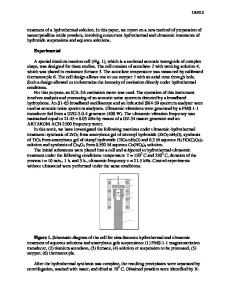Spiky niobium oxide nanoparticles through hydrothermal synthesis
- PDF / 583,312 Bytes
- 7 Pages / 584.957 x 782.986 pts Page_size
- 105 Downloads / 382 Views
Ken-ichi Kakimoto Department of Life Science and Applied Chemistry, Nagoya Institute of Technology, Nagoya 466-8555, Japan; and Frontier Research Institute for Materials Science, Nagoya Institute of Technology, Nagoya 466-8555, Japan (Received 1 January 2017; accepted 1 May 2017)
The development of ceramic nanomaterials with unique structure is necessary for discovery of novel property. We developed a novel niobium oxide nanoparticles with a spiky morphology. The spiky structure was composed of two kinds of component: niobium oxide hydrate sphere core and niobium pentoxide nanorods. These spiky niobium oxide nanoparticles are easily synthesized by hydrothermal treatment of niobium oxalate solution at 200 °C for 2 h, and their particle size could be tuned from 80 to 300 nm with 5–10 nm of nanorod on the surface by adjusting niobium concentration in the niobium oxalate solution. The band gap energy of the spiky nanoparticles was around 3.4 eV, and the spiky niobium oxide nanoparticles showed a light absorption in a wide wave length range from 380 to 700 nm. The niobium oxide nanoparticles are applicable as both solid acid catalyst and photocatalyst because of their spiky and two-layer structure.
I. INTRODUCTION
Ceramic nanomaterials with functional properties have attracted great interest in the development of sensors, catalyst, fuel cells, biomedicine, and data storage.1–4 Over the past decades, various kinds of liquid-phase synthesis methods, such as sol–gel processes and hydrothermal methods, have been developed for synthesizing fine ceramic nanomaterials and controlling their size and crystal structures.5–9 Recently, morphological control of functional nanomaterials have attracted much attention, and many ceramic nanomaterials with 0D (isotropic structure), 1D, 2D, or 3D (anisotropic structure) structures have been developed because there is a close relationship between the morphology and their properties.10–13 For example, cobalt oxide with nano-rod structure showed higher oxidative catalytic activity than that of sphere-shaped cobalt oxide even under room temperature.14 This is because atomic species or their combination affecting the catalytic activity was exposed on the particle surface by controlling the morphology. Thus, by controlling the nanostructure of existing materials, it is promising that development of novel functional materials and improvement of their properties. In addition, by using the ceramic nanomaterials as a precursor powder for thin film and bulk ceramics, not only the size but also the morphology of ceramic nanomaterial should affect the sintering behavior, and their final structures and properties should be changed. Therefore, development of Contributing Editor: Nahum Travitzky a) Address all correspondence to this author. e-mail: [email protected] DOI: 10.1557/jmr.2017.200
novel shaped ceramic nanomaterials is important for all of the various fields. Niobium oxide is widely used in biomedical, electric, and optical applications such as an implant material, a capacitor, and
Data Loading...










